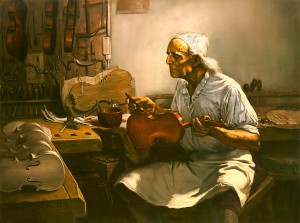Understanding what I’m about to tell you can make the difference between success and failure in your child’s violin lessons. Between a joyful experience and drudgery.
Picture this scenario:
You are beaming. Your six year old daughter is receiving enthusiastic applause from a full room of admirers. She has just performed beautifully at her first violin recital.
Or this scenario:
Your son is once again complaining about practicing. You’ve already threatened to cut off his lessons entirely if he doesn’t do better. The excitement and enthusiasm you both shared six months ago is long faded away.
[alert]The sad truth is that kids struggle and fail at violin far more often than you might expect. [/alert]
It happens because the “violin is so hard.” Or at least that’s what most people assume.
We start out expecting to suffer through months of squeaks, groans and scratches. And after that, volumes of exercises, scales and music reading are on tap. Months later, you’re still struggling to “play” your first song.
It doesn’t have to be that way. We can learn to play, really play well, from the very first note.
When I started violin, I shared many limiting thoughts. And sure enough, I was frustrated by slow progress. I worked hard, but without much focus, and achieved only a fraction of my potential, even after years.
After decades of playing in symphony orchestras and recording studios, I began to teach the violin. That’s when something remarkable happened. I stumbled upon some important people and ideas that turned my violin world upside down.
What shocked me the most is that these ideas worked even better for my students than they did for me. As a teacher who loves the violin dearly, I’d like to share them with you in this course.
After years of teaching violin, and of working with some of the finest string teachers around the nation, with each new day I believe more firmly than ever:
1. Age 6 or 60, learning the violin becomes simple, once you have mental clarity about what’s most important at any given moment.
2. The most important lessons your child must learn are the first ones. He/she must master only three basic skills.
If you take just this one concept to heart, success is practically guaranteed:
Violin lessons aren’t for learning songs.
Many people, even a few violin teachers, forget this basic fact. They lose sight of what really is crucial: with every note you play during the lesson, with every sound you make, you are focussed on learning the simple movements needed to produce a beautiful tone in the most effortless way possible.
Yes, in my studio students perform songs, and they learn to gain comfort performing them on the stage. When students demonstrate the relevant technical mastery, only then do we begin to discuss artistic interpretation of songs.
Stated another way, the best early lessons and practice sessions are less about what to play and more about how to play. How to hold the instrument and bow. Posture. Tone. Freedom of movement and lack of tension.
Focus on the “how” with your child. Let the “what” come in its own good time. You’ll discover that even playing nursery rhymes becomes joyful and pleasureful. Isn’t that why we play music in the first place?
—
If you find this information helpful, please share or tweet this page or post, using the buttons below. Thanks!

